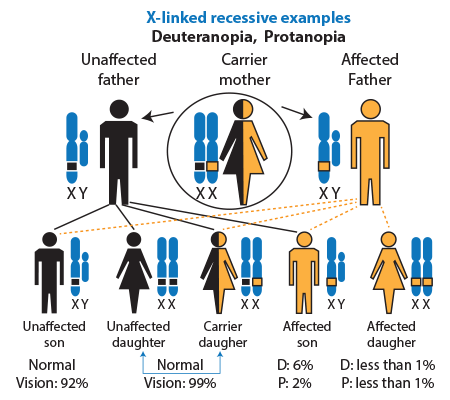Overview
It is believed that 8%-10% of the world's population is colour blind or has a colour weakness in some way. Let’s consider the world's population (est. 7.089 billion as of 2013). At first, that percentage seems small until we calculate it. Many Millions of people (mostly males) have difficulty discerning a full colour spectrum. Unfortunately, this inability to perceive these colour effects their daily living when it comes to simple tasks like choosing matching socks or in more dangerous situations such as the difference between a red or green warning light. Since a colour blind person can't rely on colour to tell him when he is in danger; there have to be other visual clues. You can find some of these examples in my Tests and Accessibility sections.
Did you know?

Diagram of the possibilities of offspring if a woman carrier marries a man with or without the colour blindness gene and the percentage in the population.
Wikipedia states the country of Australia has the highest population of colourblind people, about 8% males and 0.4% females. In the US about 7% males (10.5 million) and 0.4% females have difficultly discerning red from green. By nationality colour blindess is higher in Caucasians 8% than Asians 5% or Africans 4%.
Many forms of colour blindness?
It should be noted that there is not just one form of Colour Blindness. There are four main types:
- Protanopia - unable to receive red light
- Deuteranopia - unable to receive green light
- Tritanopia - unable to receive blue light
- Monochromacy - unable to receive any colour other than black or white
Check off or on to see percentage in Male Population - maximum 100 percent.
Percentage of Males: percent
Within these types there are 2 categories. For example, if a person only has a weakness but is still able to receive some red light the condition is called Protanomaly not Protanopia. For more on each of these types of colour blindness view each page on the topic to learn more.
